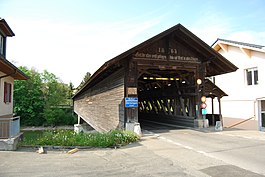Murgenthal
| Murgenthal | ||
|---|---|---|
 |
||
|
||
| Coordinates: 47°16′N 7°50′E / 47.267°N 7.833°ECoordinates: 47°16′N 7°50′E / 47.267°N 7.833°E | ||
| Country | Switzerland | |
| Canton | Aargau | |
| District | Zofingen | |
| Area | ||
| • Total | 18.65 km2 (7.20 sq mi) | |
| Elevation | 412 m (1,352 ft) | |
| Population (Dec 2015) | ||
| • Total | 2,892 | |
| • Density | 160/km2 (400/sq mi) | |
| Postal code | 4853 | |
| SFOS number | 4279 | |
| Surrounded by | Boningen (SO), Brittnau, Fulenbach (SO), Pfaffnau (LU), Roggwil (BE), Rothrist, Vordemwald, Wolfwil (SO), Wynau (BE) | |
| Website |
www SFSO statistics |
|
Murgenthal is a municipality in the district of Zofingen in the canton of Aargau in Switzerland.
Murgenthal is first mentioned in 1255 as Murgatun. The Herrschaft rights to the village belonged to the Counts of Frohburg until 1299, when they went to the Habsburgs. From the Bernese conquest of the Aargau in 1415, until 1798, the rights were held by city of Bern. Between 1640-45 the Governor of Aarburg, Jacob Wyss, build the 8.5 km (5.3 mi) Rotkanal (Red Canal) which transported water from the head waters of the Murg river to the meadows at Rothrist. Between 1798-1802 it was part of the Canton of Bern. Since 1803 it belongs to the canton of Aargau. Until 1900 the village of Murgenthal was part of the municipality of Riken. In 1901 the municipality of Riken joined the municipality of Balzenwil to form the new municipality of Murgenthal.
Under Bernese rule the villagers were part of the Wynau and Roggwil parishs. In 1817 a new parish was established and in 1901 its name was changed to the Riken Murgenthal parish. The romanesque revival parish church was built in 1852-54 in Glashütten. However, it was replaced in 1964 by a new building.
In 1857, a railway station on the Olten-Bern line was built in Murgenthal. The wooden bridge was built over the Aare river to Fulenbach in 1863. With the railroad and access to the Rotkanal, several factories were built in Murgenthal. In 1856 the Grossmann (later Künzli & Co.) weaving factory opened. In 1881 Arnold Künzli founded the knitting factory of His & Cie, which operated until 1976 in Murgenthal. Additionally, a wicker and wood products factory opened in 1894. The village continued to develop due to the railway and factories. In 1920, about 63% of the working population worked in manufacturing. By 2005 that number had dropped to only 28%. The number of jobs in the municipality has dropped to about half of the peak number in 1950 (1,485 jobs) due to factory closings.
...
Wikipedia



